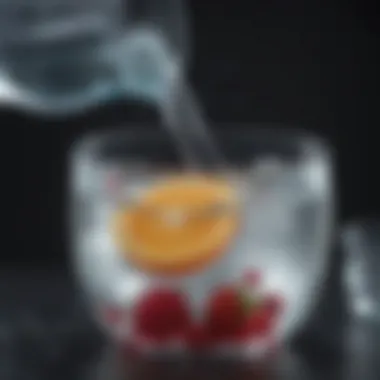Understanding Electrolyte Replenishment for Better Hydration


Intro
Electrolytes play an essential role in keeping our bodies running smoothly. It's astonishing how these small particles can affect everything from muscle contractions to nerve signaling. Now, when we lose fluids—whether through sweating, enduring illness, or simply not drinking enough water—these vital electrolytes can dwindle. And that's where replenishment comes into play.
In this article, we will peel back the layers on electrolyte replenishment and how it ties into effective hydration. We’ll explore various electrolytes essential for maintaining balance in our bodies. Unlike the oversimplified versions of health advice we often encounter, it's critical to grasp the diversity of options available, both commercially and naturally.
Moreover, we will dive into the nitty-gritty of electrolyte drinks, assessing what's on the market and comparing effective natural sources, as well as some homemade remedies that can easily be whipped up in your kitchen.
So grab a glass of water (or a tasty electrolyte-rich drink), and let's embark on this enlightening journey together.
Prologue to Electrolytes
Understanding electrolytes is essential for anyone interested in health and wellness. These minerals play a crucial role in various bodily functions, from regulating fluid balance to supporting nerve function. In today’s fast-paced world, where hydration often takes a back seat to other priorities, culminating in dehydration, awareness of electrolytes and their replenishment becomes indispensable.
Electrolytes such as sodium, potassium, calcium, magnesium, and chloride, often found in our everyday diets, are vital for maintaining homeostasis. Without these minerals, the body struggles to perform basic functions, leading to health issues that can range from mild discomfort to serious complications. Delving into the benefits and methods of effective hydration provides insights that can help individuals make informed choices about their health.
What Are Electrolytes?
Electrolytes are charged particles that dissolve in bodily fluids. They primarily come from the food we eat and the drinks we consume. For instance, when you bite into a juicy orange or sip a glass of coconut water, you’re not just enjoying a tasty treat; you're also delivering a cocktail of electrolytes into your system.
These minerals reside in your blood, urine, and various tissues and help transmit electrical signals throughout the body. This capability is what allows muscles to contract and nerves to communicate effectively. For example, when you feel a sudden twinge in your leg from overexertion, that’s your muscles reacting to the signals mediated by electrolytes.
The Importance of Electrolytes in the Body
Electrolytes play pivotal roles in maintaining overall health. Their importance can’t be overstated, and here's why:
- Fluid Balance: Electrolytes help regulate water levels in and out of cells, which is critical for hydration.
- Muscle Function: Sodium and potassium are particularly significant for muscle contraction. A drop in these levels can lead to cramps, fatigue, or weakness.
- Nerve Transmission: Electrical impulses in the nervous system rely on electrolyte balance. Disruption can affect everything from reflexes to brain function.
- Acid-Base Balance: Electrolytes help maintain the pH level in the body, ensuring that it functions optimally. An imbalance can affect metabolic processes.
"Electrolytes are the unsung heroes of hydration, quietly ensuring our bodies run like a well-oiled machine."
In summary, understanding what electrolytes are and grasping their significance lays the groundwork for appreciating the nuances of hydration strategies. Incorporating proper hydration practices that factor in electrolyte balance can enhance physical performance, promote recovery, and ultimately improve well-being.
Types of Electrolytes
Understanding electrolytes means appreciating their diverse functions within the human body. Electrolytes are the charged particles that help maintain the body's fluid balance, acid-base balance, and overall function of muscles and nerves. Each type has its unique role, and while they work synergistically, each fulfills specific tasks essential to our health. From regulating hydration levels to supporting nerve function, knowing about the different kinds can guide individuals in their choices for effective replenishment.
Sodium
Sodium handles a key role in maintaining fluid balance. It's primarily found in extracellular fluid and aids in regulating blood pressure and blood volume. When you sweat, sodium is one of the first electrolytes lost. Consuming adequate salt in your diet is crucial. However, be mindful, as excessive intake can lead to hypertension. Foods rich in sodium include table salt, pickles, and canned soups, but if someone is watching their blood pressure, they need to tread carefully.
Potassium
Next up is potassium. This powerhouse mineral is critical for sending nerve signals and contracting muscles. It resides mostly inside cells, counterbalancing the sodium outside. When levels dip, symptoms like muscle cramps or fatigue can emerge. Bananas might be the first food that comes to mind, but avocados, sweet potatoes, and spinach pack a potassium punch too. It's essential for heart health, so making it part of a balanced diet can yield substantial benefits.
Calcium
Calcium is synonymous with strong bones and teeth. However, its role transcends just structural support; it is a vital player in muscle contractions and nerve signaling. People often think of dairy when considering calcium sources, but leafy greens (like kale and broccoli), almonds, and fortified plant milks can also provide this important electrolyte. Keeping calcium levels adequate is especially crucial, as deficits can lead to muscle spasms or more serious health issues over time.
Magnesium
Then there's magnesium, often regarded as the unsung hero among electrolytes. This mineral is involved in over 300 biochemical reactions in the body. From energy production to the synthesis of DNA, magnesium keeps the wheels turning. Foods like dark chocolate, seeds (pumpkin and chia), and legumes are excellent sources. Low levels can lead to muscle cramps, fatigue, and even anxiety. Ensuring a good intake through diet can thus not only help physical performance but also mental well-being.
Chloride
Last, but by no means least, is chloride. Frequently found in conjunction with sodium, chloride balances fluids and aids the body in maintaining a proper pH level. It forms a component of hydrochloric acid in the stomach, which is crucial for digestion. Table salt often contains chloride, but it's also present in foods like tomatoes, lettuce, and olives. While it's not often singled out, maintaining adequate levels can support overall hydration and digestive health.


A well-balanced diet incorporating these various electrolytes is vital for optimal health, especially when engaging in physical activities or during the hotter months.
Signs of Electrolyte Imbalance
Recognizing the signs of electrolyte imbalance is crucial for maintaining health. When electrolytes are out of whack, your body can throw a little tantrum, leading to a variety of symptoms. An imbalance can stem from a range of factors, including dehydration, excessive exercise, or underlying medical conditions. Being attuned to how your body feels can help you catch problems before they escalate.
Symptoms of Dehydration
Dehydration occurs when your body loses more fluids than it takes in, which can disrupt the delicate balance of electrolytes. The signals your body sends—including thirst, dry mouth, and fatigue—are classic indicators. But they’re not the only signs.
- Dizziness or light-headedness: Standing up quickly may feel like a dizzy spell.
- Muscle cramps: If your legs are spasming or your muscles feel tight, that could be a cry for help from your electrolytes.
- Dark urine: Bright yellow may be fine when the sun shines, but if your pee is darker than usual, it might mean you need to hydrate.
- Rapid heartbeat: An elevation in heart rate might indicate that your body is struggling to maintain balance.
Awareness of these signs can be a game changer. For example, a simple test of your hydration level can involve checking your urine color. If it’s a pale yellow, you’re likely in the clear. If it’s darker, then a glass of water is in immediate order.
Potential Health Risks
Ignoring the signs of electrolyte imbalance can lead to serious health consequences. Prolonged dehydration can evolve into chronic issues, leaving lasting effects on your body. Some potential health risks include:
- Severe dehydration: When electrolyte levels become dangerously low, hospital visits could be on the docket.
- Kidney stones: Dehydration can lead to concentrated urine, forming stones over time.
- Muscle weakness: Low potassium levels can cause muscle function to plummet, leading to weakness or even paralysis in extreme cases.
- Heart problems: An imbalance can wreak havoc on electrical signals in the heart, potentially leading to arrhythmias.
"Your body talks to you; you just have to listen."
It’s advisable to keep an eye out for these symptoms and risks, especially during heat waves or intense workouts. Taking proactive measures can not only optimize your hydration strategy but also keep potential health issues at bay. When in doubt, it’s wise to consult a healthcare professional. Taking care of your electrolyte balance is not just a recommendation; it's a necessity for a thriving life.
Causes of Electrolyte Loss
Electrolyte loss is a critical aspect of maintaining proper body chemistry and function. Understanding the causes behind this depletion can help individuals better address hydration needs and optimize their electrolyte levels. In this section, we dive into two main elements that contribute to electrolyte loss: physical activity and health conditions.
Exercise and Physical Activity
When engaging in physical activity, the body demands an increased supply of resources, particularly fluids. As one sweats, electrolytes such as sodium, potassium, and chloride are lost through perspiration. This is especially true in endurance sports, like marathon running or cycling, where prolonged exertion leads to a significant drop in these crucial minerals. To illustrate, let's consider a soccer player running about 11 kilometers in a single match; without appropriate hydration strategies, they could easily lose several grams of sodium in just one game.
Here are some noteworthy aspects regarding electrolyte loss during exercise:
- Hydration Strategies: It's often recommended to drink fluids that both hydrate and replenish lost electrolytes during prolonged exercise. A lack of proper hydration can lead to cramping and fatigue, which can quickly sideline even seasoned athletes.
- Intensity Levels: The more strenuous the activity, the more likely electrolyte loss will occur. This is where awareness of one’s own body signals is paramount; don’t wait until thirst strikes to rehydrate, as this could already be a sign of early dehydration.
- Environment: Heat and humidity can amplify sweating, resulting in a faster depletion of electrolytes. Those exercising outdoors in tropical climates need to be particularly vigilant.
Given these realities, it’s vital for anyone involved in physical activity to monitor their hydration and electrolyte levels closely.
Illness and Medical Conditions
Electrolyte imbalances can also stem from various illnesses and medical conditions. These range from gastrointestinal issues to endocrine disorders, which disrupt the body’s natural balance of these essential minerals. If one finds themselves frequently feeling drained or unwell, it might be wise to consider if an underlying condition could be at play.
Here are a couple of notable causes of electrolyte loss due to illness:
- Diarrhea and Vomiting: These unfortunate conditions can lead to massive electrolyte loss, especially potassium and sodium. When the body is unable to absorb essential nutrients due to gastrointestinal distress, proper electrolyte levels can dwindle quickly.
- Chronic Conditions: Certain long-term health issues like diabetes can impact how the body processes electrolytes. For instance, individuals with uncontrolled Diabetes Mellitus may encounter problems with sodium levels.
- Medications: Diuretics, commonly prescribed for heart conditions, can lead to an increase in urinary output, resulting in a notable loss of electrolytes.
In circumstances of illness or chronic conditions, consulting with healthcare professionals to monitor electrolyte levels should be a priority. Regular check-ups can prevent severe imbalances that lead to more significant health issues.
Through understanding these causes of electrolyte loss, individuals can take proactive steps to maintain balance in their bodies, paving the way toward overall better health.
Replenishing Electrolytes: Methods and Considerations
Replenishing electrolytes is crucial for maintaining bodily functions and overall health, particularly when the body loses fluids—like during intense exercise, illness, or excessive heat. It’s not just about drinking water; one must ensure that the right balance of salts is restored to keep muscles functioning, nerves firing, and hydration levels optimized. The discussion of methods available for replenishing electrolytes opens the door to various approaches, each offering unique benefits and considerations.
Commercial Electrolyte Drinks


Types of available drinks
When you stroll through the beverage aisle, you’ll find a plethora of options touting electrolyte benefits. These commercial drinks can be categorized into sports drinks, electrolyte-infused waters, and powdered mixes.
- Sports drinks are often loaded with sugars, sodium, and potassium. They are formulated to quickly replenish lost electrolytes during rigorous activities.
- Electrolyte-infused waters present a refreshing alternative, containing minimal calories yet providing essential minerals like potassium and magnesium.
- Powdered mixes can be convenient, as they allow one to customize concentrations and flavors to suit personal tastes, making hydration versatile.
These drinks are a solid choice when quick replenishment is needed, especially post-exercise; however, some may still lean heavy on sugar, which can be a double-edged sword.
Evaluating nutritional information
Understanding nutritional information on labels can feel like decoding hieroglyphs for some, but it’s vital for making informed decisions. By peering into the numbers, one can determine the quantities of sugars, calories, and electrolytes per serving.
This evaluation is essential for several reasons:
- Sugar content: High sugar can lead to energy spikes followed by crashes, hindering performance.
- Electrolyte balance: It is key to ensure an adequate representation of sodium, potassium, magnesium, and calcium to meet one's needs.
- Caloric count: Depending on your personal goals—be it weight loss or muscle gain—this aspect is quite significant.
Ultimately, the nutritional breakdown of these drinks informs choices, so you don’t end up with a bottle that performs more like liquid candy than a health aid.
Natural Sources of Electrolytes
Fruits and Vegetables
Fruits and vegetables are nature’s own medicine cabinets, packed with essential nutrients, including electrolytes. Bananas, avocados, spinach, and coconut water are standout examples.
- Bananas boast high potassium levels, essential for muscle contraction and nerve function.
- Coconut water is often dubbed a natural sports drink, as it contains all the necessary minerals in a refreshing and hydrating form.
- Spinach is not just a Popeye favorite; it’s also rich in magnesium, aiding in muscle recovery.
Their appeal lies in their holistic profile, meaning you get fiber and antioxidants alongside electrolytes, making them a popular and healthy choice.
Nuts and Seeds
Nuts and seeds should not be overlooked either, as they too are excellent sources of key electrolytes. Almonds, walnuts, chia seeds, and flaxseeds stand out.
- Almonds are heavy on the magnesium, vital for energy production and muscle function.
- Chia seeds offer a delightful preparation option—soak them in water or blend into smoothies for a nourishing boost.
These foods score high on convenience and health benefits; however, portion control is necessary due to their calorie density.
Homemade Electrolyte Solutions
Simple recipes
Homemade electrolyte solutions are a true testament to culinary creativity. By using common kitchen staples, one can whip up effective drinks. A basic recipe might include:
- 1 liter of water
- Juice of 1 lemon
- 2 tablespoons of honey
- A pinch of salt
Mix it up, and voilà! You have a revitalizing drink that boasts natural ingredients without the additives or mystery sweeteners. It’s not only cost-effective but also customizable.
Benefits of DIY solutions
The benefits of crafting your own electrolyte drink are manifold. Control over ingredients means you can tailor sweetness, caloric intake, and the salts used depending on individual health needs. Moreover, there’s a certain satisfaction that arises from creating a solution from the ground up.
However, there can be a learning curve; getting the balance right may take a few attempts. But once mastered, homemade solutions can be just as effective—if not more—than store-bought varieties, without the unnecessary additives.
The ability to tailor your hydration solutions greatly enhances personal wellness.
In summary, whether you opt for commercial electrolyte drinks, reach for fruits and vegetables, or dabble in homemade remedies, understanding their contributions helps ensure that hydration serves its vital role in your everyday wellbeing.


Hydration Strategies for Optimal Health
Staying properly hydrated is a cornerstone of maintaining optimal health. It's not just about slinging back water like there's no tomorrow; it's about understanding how hydration impacts various aspects of your physical well-being. Whether you consider yourself a fitness enthusiast or simply someone trying to make healthier choices, implementing effective hydration strategies can significantly elevate your daily life.
A crucial element in any hydration plan is being mindful of your body's unique needs. Factors like activity levels, climate, and even your current health status play pivotal roles in how much fluid you should consume. Here, we'll look at two key areas: first, considerations for physical activity; second, how to set daily hydration goals.
Physical Activity Considerations
Physical activity can greatly affect your hydration needs. The more you move, the more you sweat, and the higher your fluid losses become. When you're sweating buckets, it's not just water that's lost; you also shed electrolytes that are vital for muscle function and overall health.
- Pre-Exercise Hydration: Before you even lace up your sneakers, make sure to hydrate adequately. A good rule of thumb is to drink 16 to 20 ounces of water about two to three hours before you work out.
- During Exercise: While you're burning calories, drink about 7 to 10 ounces every 10 to 20 minutes. This helps replenish what you're losing while keeping your energy levels stable.
- Post-Exercise Recovery: After you've hit your fitness goals for the day, don't forget to rehydrate! The body needs replenishing to recover effectively. Aim for at least double the amount of fluid lost during exercise in the following hours.
"Hydration is a key ingredient to enhance both performance and recovery. Don’t wait until you’re thirsty—be proactive!"
Daily Hydration Goals
Establishing daily hydration goals is more than just a number; it's a tailored approach to fit into your lifestyle. Here’s how to think about it:
- General Recommendation: The eight 8-ounce glasses of water per day is a well-known guideline, but consider it a starting point. Individual needs can vary significantly based on many factors.
- Body Weight Factor: A more personalized way to calculate hydration needs is using your weight. Aim to drink about half an ounce to an ounce of water for every pound you weigh.
- Monitor Urine Color: Your body's signals can guide you. Keeping an eye on your urine color can indicate hydration status. Light yellow usually means you're in the clear, while darker shades signal that you might be running low on fluids.
Incorporating these strategies into your daily routine can enhance your energy levels, cognitive function, and physical performance. Essentially, staying on top of your hydration game can lead to a more vibrant life. Make it part of your health journey and you'll find it pays off in numerous ways.
Evaluating Electrolyte Products
In the quest to maintain proper hydration and electrolyte balance, evaluating electrolyte products becomes a crucial step. With the multitude of options available, distinguishing good choices from the mediocre ones can be akin to searching for a needle in a haystack. The aim here is to empower consumers by uncovering essential elements to consider before purchasing these often trendy beverages. Understanding the ingredients and overall quality of products plays a significant role in ensuring that they meet the body's needs efficiently.
When it comes to hydration, not all products are created equal. Some might be laden with sugars and artificial additives, while others provide pure, functional hydration. A conscientious approach to selecting electrolyte products ultimately translates to better health outcomes.
"Quality over quantity helps avoid the pitfalls of empty calories and instead offers the body what it truly craves."
Key Ingredients to Look For
When scrutinizing electrolyte products, attention must be paid to the ingredient list. Below, we illuminate several key components that can foster better hydration and balance within the body:
- Sodium: Often considered the primary electrolyte, sodium helps regulate fluid balance. Look for products with a reasonable amount, as too much can lead to unintended health issues.
- Potassium: This essential mineral works in tandem with sodium to help maintain proper nerve and muscle function. It’s vital for rehydration, especially post-exercise.
- Magnesium: This mineral plays a key role in muscle relaxation and nerve impulses. It may assist in reducing muscle cramping, making it valuable for athletes and active individuals.
- Chloride: Working alongside sodium, chloride helps maintain hydration and acid-base balance.
- Natural Sweeteners: Products with natural sources of sweetness, like stevia, can be a better alternative than those containing high fructose corn syrup or other sugary additives.
With these ingredients in mind, it's crucial to check for unnecessary fillers, artificial colors, and preservatives which might disguise an otherwise beneficial product.
Brands and Quality
The brand of electrolyte product can significantly impact quality. Choosing reputed brands can provide an assurance of accountability and care in their formulations. There are several core aspects to consider while assessing brands:
- Transparency: A brand that clearly lists its ingredients, sourcing, and nutritional information tends to portray confidence in its product. Look for brands that provide detailed labeling, including the percentages of each electrolyte present.
- Reputation: Research the brand's history. Online reviews, testimonials, and third-party certifications can provide insights into product quality and customer satisfaction. Popular brands like Pedialyte, Gatorade, and Nuun are often compared by consumers, but don't shy away from lesser-known local brands that might offer quality products.
- Research and Development: Brands that invest in research to formulate their products often create formulas backed by scientific evidence. Check if they conduct clinical trials or utilize qualified nutritionists in their development processes.
Epilogue
Electrolyte replenishment is not just a matter of choice; it's a necessity for sustaining optimal health. Throughout this article, we've examined the multifaceted roles that electrolytes play in our bodies, as well as the ways to restore these vital substances when they are depleted. Recognizing the signs of electrolyte imbalance—such as fatigue, cramping, or dizziness—empowers individuals to act quickly in restoring balance. Moreover, our exploration of various hydration methods—from commercial drinks to natural sources—illuminates the importance of making informed choices regarding what we consume.
Among the key benefits, hydration supports muscle function, maintains organic systems, and enhances overall physical performance. For anyone engaged in sports, rigorous activities, or simply navigating everyday life, understanding how to replenish electrolytes adequately has tremendous implications for well-being. It's a gift we can give ourselves and our bodies to ensure longevity and vitality.
"Hydration is the vital link between performance and recovery—in other words, don't overlook it."
Thus, considering the practical methods of replenishment, such as consuming bananas for potassium or sipping on coconut water for natural hydration, can lead to better choices. Whether appealing to those savvy about nutrition or newcomers willing to learn, the insights here provide a solid foundation for effective hydration strategies.
Summary of Key Points
- Importance of electrolytes for bodily functions.
- Signs of electrolyte imbalance to look out for.
- Different sources for replenishing electrolytes: commercial products, natural options, and DIY solutions.
- Hydration strategies to support physical activity and health goals.
Final Thoughts on Electrolyte Replenishment
In the grand tapestry of health, electrolyte replenishment holds a vital thread. Staying properly hydrated is not merely about quenching thirst but also about nurturing every cell in the body. As mind and body tackle daily challenges, optimal electrolyte intake can mean the difference between fatigue and vigor.
In the rapidly evolving landscape of nutrition, keeping abreast of new studies or innovations can further enhance our understanding. So, don't just skim the surface; dive deeper into how electrolytes work in tandem with your unique physiology. After all, it’s not just about hydration; it’s about fortifying your body for whatever life throws your way.







